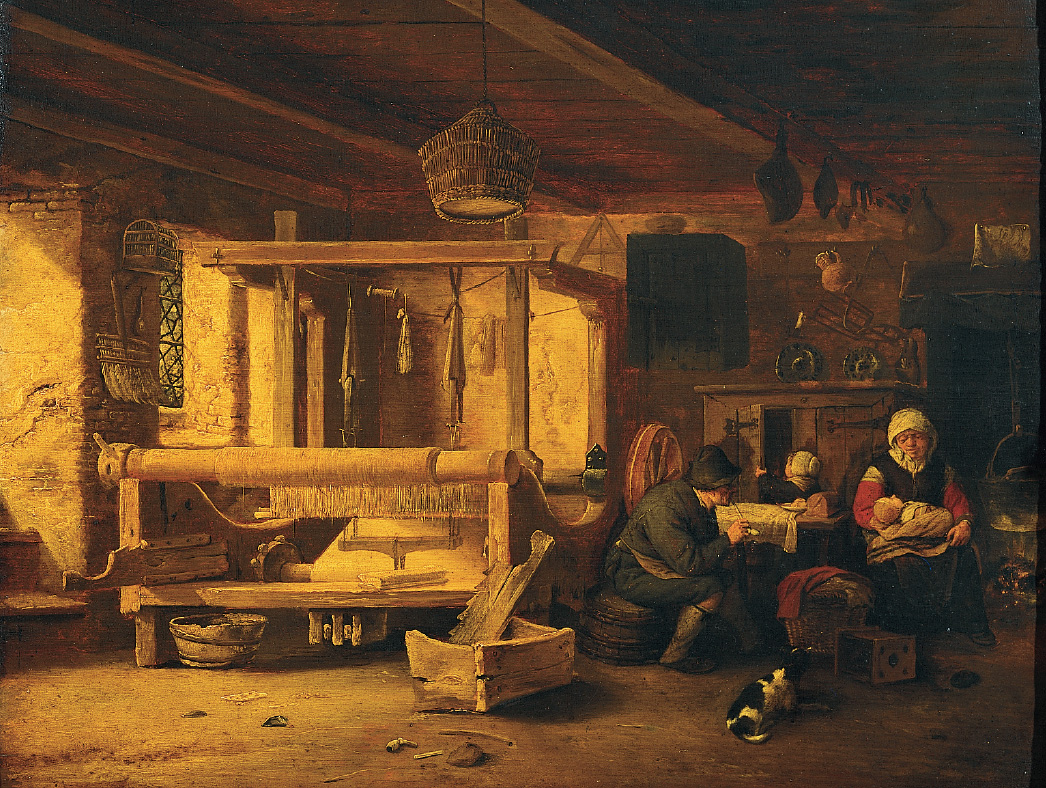The Lives of Rural Textile Workers
Until the nineteenth century, the industry that employed the most people in Europe was textiles. The making of linen, woolen, and eventually cotton cloth was the typical activity of cottage workers engaged in the putting-out system. A look inside the cottage of the English weaver illustrates a way of life as well as an economic system. The rural worker lived in a small cottage with tiny windows and little space. The cottage was often a single room that served as workshop, kitchen, and bedroom. There were only a few pieces of furniture, of which the weaver’s loom was by far the largest and most important. That loom changed somewhat in the early eighteenth century when John Kay’s invention of the flying shuttle enabled the weaver to throw the shuttle back and forth between the threads with one hand. Aside from that improvement, however, the loom was as it had been for much of history and as it would remain until the arrival of mechanized looms in the first decades of the nineteenth century.
Handloom weaving was a family enterprise. All members of the family helped in the work, so that “every person from seven to eighty (who retained their sight and who could move their hands) could earn their bread,” as one eighteenth-century English observer put it.4 Operating the loom was usually considered a man’s job, reserved for the male head of the family. Women and children worked at auxiliary tasks; they prepared the warp (vertical) threads and mounted them on the loom, wound threads on bobbins for the weft (horizontal) threads, and sometimes operated the warp frame while the father passed the shuttle.
The work of four or five spinners was needed to keep one weaver steadily employed. Since the weaver’s family usually could not produce enough thread, merchants hired the wives and daughters of agricultural workers, who took on spinning work in their spare time. In England, many widows and single women also became “spinsters,” so many in fact that the word became a synonym for an unmarried woman. In parts of Germany, spinning employed whole families and was not reserved for women.
Relations between workers and employers were often marked by sharp conflict. (See “Primary Source 17.2: Contrasting Views on the Effects of Rural Industry.”) There were constant disputes over the weights of materials and the quality of finished work. Merchants accused workers of stealing raw materials, and weavers complained that merchants delivered underweight bales. Suspicion abounded.
Conditions were particularly hard for female workers. While men could earn decent wages through long hours of arduous labor, women’s wages were usually much lower because they were not considered the family’s primary wage earner. In England’s Yorkshire wool industry, a male wool comber earned a good wage of 12 shillings or more a week, while a female spinner could hope for only 3½ shillings.5 A single or widowed spinner faced a desperate struggle with poverty. Any period of illness or unemployment could spell disaster for her and any children she might have. In 1788 one English writer condemned the low wages of spinners in Norwich: “The suffering of thousands of wretched individuals, willing to work, but starving from their ill requited labour; of whole families of honest industrious children offering their little hands to the wheel, and asking bread of the helpless mother, unable through this well regulated manufacture to give it to them.”6

From the merchant capitalist’s point of view, the problem was not low wages but maintaining control over the labor force. Cottage workers were scattered across the countryside and their work depended on the agricultural calendar. In spring and late summer planting and haymaking occupied all hands in the rural village, leading to shortages in the supply of thread. Merchants bitterly resented their lack of control over rural labor because their own livelihood depended on their ability to meet orders on time. They accused workers — especially female spinners — of laziness, drunkenness, and immorality. If workers failed to produce enough thread, they reasoned, it must be because their wages were too high and they had little incentive to work.
Merchants thus insisted on maintaining the lowest possible wages to force the “idle” poor into productive labor. They also lobbied for, and obtained, new police powers over workers. Imprisonment and public whipping became common punishments for pilfering small amounts of yarn or cloth. For poor workers, their right to hold on to the bits and pieces left over in the production process was akin to the traditional peasant right of gleaning in common lands. With progress came the loss of traditional safeguards for the poor.